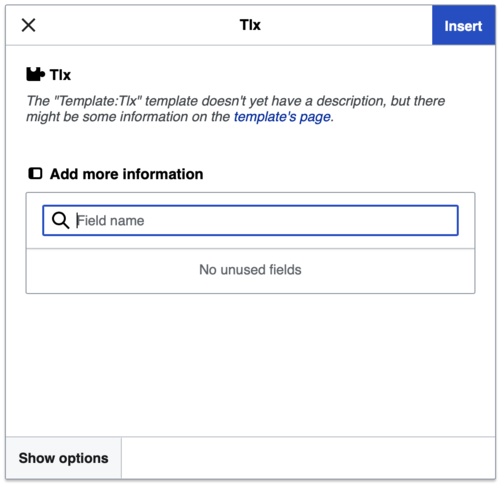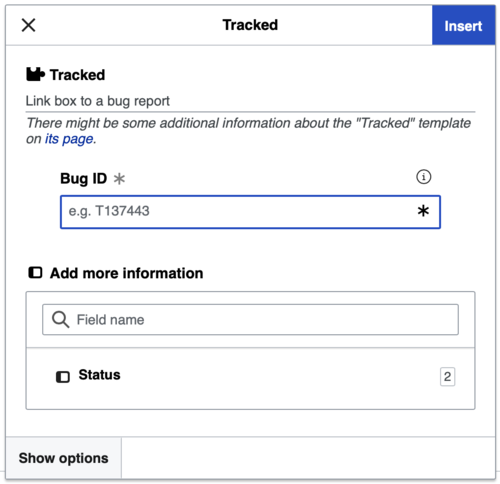Tɛmplet:For-text/doc
| This is a documentation subpage for Tɛmplet:For-text. It contains usage information, categories and other content that is not part of the original tɛmplet page. |
Usage[mali mi di yibu sheena n-niŋ]
Modelled after {{for}}, {{for-text}} was created to allow custom text, including such modifications as quotation marks or a link, as part of both a topic and its suggested article.
Note: you must supply any formatting manually (unlike {{For}}, parameters aren't automatically bluelinked)
With one topic[mali mi di yibu sheena n-niŋ]
{{For-text|TOPIC|CUSTOM TEXT}}→
With more than one topic[mali mi di yibu sheena n-niŋ]
This template also supports up to five topics and their suggested articles:
{{For-text|TOPIC|CUSTOM TEXT|TOPIC 2|CUSTOM TEXT 2}}→{{For-text|TOPIC|CUSTOM TEXT|TOPIC 2|CUSTOM TEXT 2|TOPIC 3|CUSTOM TEXT 3|TOPIC 4|CUSTOM TEXT 4|TOPIC 5|CUSTOM TEXT 5}}→
Wikilinks and capitalization[mali mi di yibu sheena n-niŋ]
Style note: When the context around a wikilink discusses the destination article itself (e.g., For more information, see Xyz; Main article: Xyz; This is discussed in Xyz) rather than the topic of that article (e.g., Tailors often use xyz on their clients' pants), use the capitalization of the article's title in the wikilinked text: [[Xyz]]. The same applies to subheadings: [[Xyz#PDQ|Xyz § PDQ]].
TemplateData[mali mi di yibu sheena n-niŋ]
| This tɛmplet needs to be updated. Please help update this tɛmplet to reflect recent events or newly available information. |

- Main page
- Feedback at MediaWiki or local feedback
- Sandbox (no account required)
- Why are the developers building this?
- Documentation:
- Development:
- Customization
- Known problems
- Requests for Comments (RfCs): Jul 2013 a, Jul 2013 b, Jul 2015, Sep 2015
What is template data?[mali mi di yibu sheena n-niŋ]
Template data is the standardized description of a template, used by the default VisualEditor, the optional 2017 wikitext editor and other tools to improve the template-editing experience for the user. Both VisualEditor and the 2017 wikitext editor include a wizard to edit templates, but for the wizard to be most useful, it needs to present specific information to the user about each template, such as a short description of the template's purpose and its parameters. This information is codified formally (by any wiki editor) using template data.
Editing without template data[mali mi di yibu sheena n-niŋ]
Without template data, each parameter needs to be added manually when inserting a new template.
No information is provided about what the value of the parameter should be.
Editing with template data[mali mi di yibu sheena n-niŋ]
With template data, a list of supported parameters (and their description) is provided for the template.
Template data provides context for each parameter, and makes it much easier for users to modify templates.
Adding template data[mali mi di yibu sheena n-niŋ]
Anyone can help by adding template data to templates (particularly high-profile ones, such as infoboxes) so that they are easier to edit in VisualEditor. The following is a minimal example, placed on a template's documentation page:
<templatedata>{
"description": "insert description here",
"params": {
"first parameter": {
"label": "x",
"description": "x",
"type": "string",
"suggested": true,
"autovalue": "derived automatic value",
"default": "default value",
"required": false
}
}
}</templatedata>
You can also add or edit template data using a GUI, by pressing the following button which appears at the top of the edit page:
The template data tutorial explains in detail how to add template data information to a template.
Adding suggested values for parameters[mali mi di yibu sheena n-niŋ]
The parameter property suggestedvalues lets you define a list of parameter values to be shown to VisualEditor users in a dropdown for easy selection. This can be done either directly in JSON or using the TemplateData editor with no coding required. Both methods are explained in detail below.
Once the values have been added to template data, the VisualEditor will display them in a combo box (a dropdown into which users can also enter a custom value). The user selects the desired value by clicking on it. If the list of values is long - for example, a list of a country’s states - the user can begin typing in the field, whereupon the list will be filtered to show only values containing the typed text. To change an entered value, the user must simply clear the field, and the full dropdown list will appear again. If the user needs a value not included in the list (for example, "message in a bottle") they can type it in manually.
For suggested values to be displayed in the VisualEditor, the parameter’s type must be set to one of the following options:
- content
- line
- string
- number
- unknown
- unbalanced wikitext.
Other types (file, page, template, user, date, boolean, URL) are not currently supported because they have special functionalities in the VisualEditor already (such as autocomplete) which would interfere with the dropdown menu for suggested values in the VisualEditor.
Adding suggested values for parameters in wikitext[mali mi di yibu sheena n-niŋ]
To add suggested values to any parameter type, add the new property “suggestedvalues” to the parameter in JSON. The “suggestedvalues” attribute must be a list of strings.
An example might look like this:
"media_type": {
"label": "Type of media",
"example": "Newspaper",
"type": "string",
"description": "In what medium was the article published?",
"suggestedvalues": [
"Journal",
"Book",
"Newspaper",
"Magazine"
]
}
Adding suggested values for parameters with the template data editor[mali mi di yibu sheena n-niŋ]
For the parameter types listed above, you can add suggested values using the template data editor.
Step 1. Click on "Manage TemplateData".
Step 2. Click on the name of the parameter you want to add suggested values to.
Step 3. If it’s not already, set the type of the parameter to one of the following: content, line, string, number, unknown or unbalanced wikitext. A new input field "Suggested values" will appear. If the parameter is already set to one of these types, the input field should already be visible.
Step 4. Type in the suggested value(s), including any spaces and special characters, and press enter to add it to the list.
Here you can see an example of how to add suggested values in the TemplateData editor.
Used templates[mali mi di yibu sheena n-niŋ]
See also[mali mi di yibu sheena n-niŋ]
- Wikipedia:VisualEditor/TemplateData/List A list of all pages with template data
This template lists up to five articles on alternative meanings of a term. For further details and examples see the template documentation.
| Parameter | Description | Type | Status | |
|---|---|---|---|---|
| First description | 1 | A phrase describing an alternative meaning
| String | required |
| First link | 2 | A phrase including a wikilink to the first alternative meaning.
| String | required |
| Second description | 3 | A phrase describing another meaning, if any
| String | optional |
| Second link | 4 | A page to link to for another meaning, if any.
| String | optional |
| Third description | 5 | A phrase describing another meaning, if any | String | optional |
| Third link | 6 | A page to link to for another meaning, if any. | String | optional |
| Fourth description | 7 | A phrase describing another meaning, if any | String | optional |
| Fourth link | 8 | A page to link to for another meaning, if any. | String | optional |
| Fifth description | 9 | A phrase describing another meaning, if any | String | optional |
| Fifth link | 10 | A page to link to for another meaning, if any. | String | optional |




